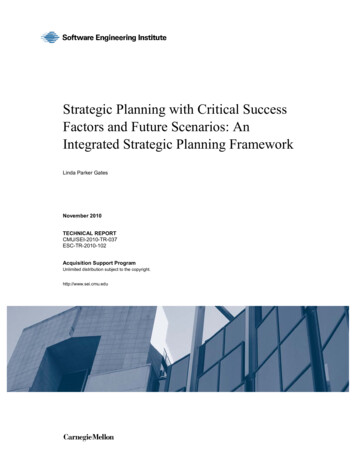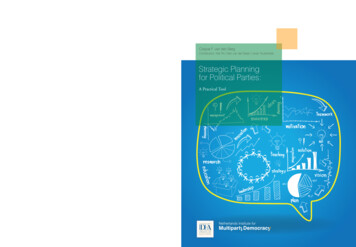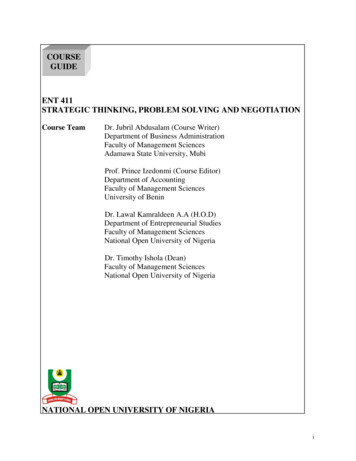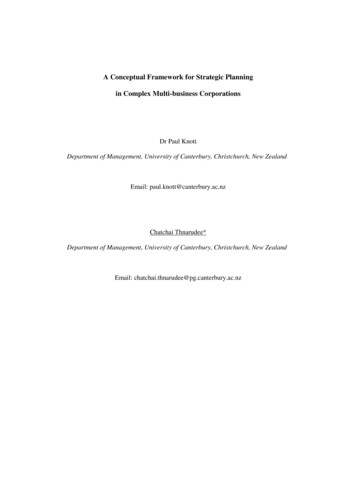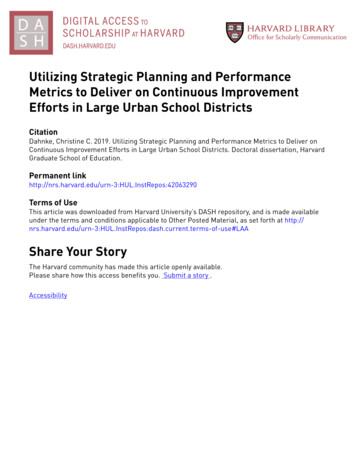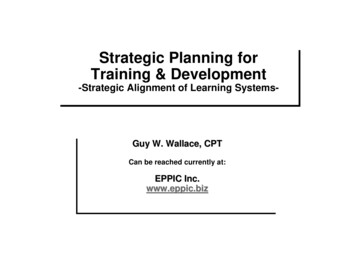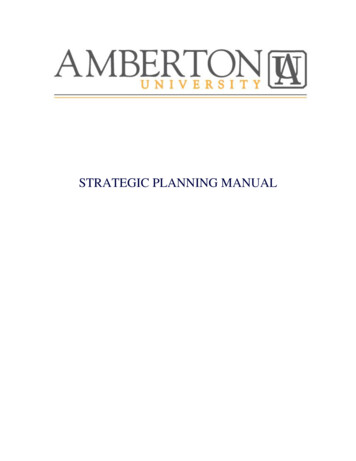
Transcription
STRATEGIC PLANNING MANUAL
AMBERTON UNIVERSITYSTRATEGIC PLANNING MANUALRevisedJune 2016
STRATEGIC PLANNING MANUALTable of ContentsSECTION ONE: An Introduction to Strategic Planning andDefinition .1Functions of Strategic Planning .1The Scope of Strategic Planning .1Methodology and Scope .2Organizational Design .3Exhibit A: Authority Chart .5Exhibit B: Major Operational Areas and Components .6SECTION TWO: The Mission of Amberton UniversityPurpose Statement .7Amberton University Affirms .8SECTION THREE: GoalsThe Life Cycle of Goals .9Exhibit C: The Making of A Goal .12Procedures for Evaluating Goals .13The Impact of A Goal on The University .14Exhibit D: The Impact of A Goal On The University .15Exhibit E: Budget Assessment and Process .16SECTION FOUR: Steps in Strategic PlanningElements Included in the Strategic Planning Steps.17SECTION FIVE: Assessing ToolsAssessing Tools .23Exhibit F: The Strategic Planning Process.29SECTION SIX: Bringing It All TogetherGoals and the Futuristic Master Plan .30
SECTION ONEAN INTRODUCTION TO STRATEGIC PLANNING AND CONTROLThe responsibility for strategic planning and control rests with the President who, asChief Executive Officer of the corporation, has the specific duty to oversee and control theessential planning elements of the University. In order to handle the daily activities andcoordination of strategic planning and control, an administrator will assume the duties of theVice President for Strategic Planning and Control.DEFINITIONThe concept of strategic planning and control (SP/C) is best understood by definingterms. Strategic refers to all the elements that are critical and essential to the present andfuture operations of the University. Planning is the detailing of a scheme or method for theaccomplishment of an objective. Thus, strategic planning implies the defining of goals orobjectives, as well as identifying the methodologies to be employed for accomplishing thegoals.Control is the process whereby factual pieces of information are gathered, interpreted,and compared to pre-defined standards to assure quality standards and goal satisfaction. Thisprocess is often referred to as assessing outcomes.FUNCTIONS OF STRATEGIC PLANNING AND CONTROLThe planning and control functions of the Office for SP/C are designed to assistinstitutional leaders with planning and in making decisions. The SP/C office is involved inmission reviewing, goal setting/attaining, self-analyzing, outcome assessing, futureprojecting, and future planning. From these endeavors, a broad model is developed. Themodel is designed to produce a flexible profile (not a rigid plan, but a framework for action),an image of the future intended for the University.THE SCOPE OF STRATEGIC PLANNINGUsually, planning is characterized by emphasizing either short-term or long-rangeplanning models. Short-term planning covers a period from six months to three years. Longrange planning normally exceeds three years and often emphasizes five to seven yearplanning models. At Amberton University, strategic planning is a process that has no end. Ithas benchmarks, but planning will not reach completion in eighteen months or in five years.Regularly, goals are assessed. If a goal is worthy of accomplishment, whether it takes a year,five years, or ten years, it will be pursued until achieved. Thus, the strategic planningprocess of Amberton University is a continuous, sliding plan that is composed of goals andobjectives of both a short-term and long-range perspective. To Amberton University,strategic planning is an ongoing process of planning steps that allow for continuousreevaluation and reshaping of the University’s future.1
METHODOLOGY AND SCOPEAmberton University utilizes the Strategic Planning Manual to assure compliance to themission statement of the University and to control the process for formulating andcompleting institutional goals.The strategic planning function of the University is ongoing, with formal reviews andupdates made annually. In addition to goals development and compliance,Amberton must ensure the:Ethical treatment of students in such matters as truth in advertising, refunds afterwithdrawal from a course, adjudication of grievances, and maintenance of privacy.Ethical treatment of employees in hiring, performance review, adjudication ofgrievances, workload and remuneration.Appropriate balance of centralization and decentralization in decision-makingresponsibilities and authority relative to the Board, administration, faculty, and staff.Management processes that foster institutional efficiencies, enabling the institution torespond to priorities.Institution’s procedures, making sure that methodologies are designed to help developthe whole student by refraining from doing for the student what the student can do for his/herself.Continual development and professionalism of all personnel in dealing with students,the public and co-workers.Principle that all University services are provided on a first come, first serve basis withno partiality shown to anyone.Coordination of course offerings to degree programs and student needs in order tomaintain a good balance between classes offered and the program needs of students.Continual evaluation of methodologies for reviewing academic programs, courses andoperational processes.Merits of learning outcomes relative to specific courses and programs; such reviews willinclude the evaluation of performance for certifications or licensure and any other standardsthat enable direct comparisons of the student’s performance with others in similar settings.Success of students in terms of retention and graduation rates.Academic credentials of the faculty and the faculty’s “fitness for purpose” in teaching inrelevant areas and delivery methodologies.2
Scope and nature of the curriculum and research resources meet the needs of thestudents and the generally accepted standards of an accredited University.Continual evaluation of University programs, procedures and methodologies, both bysession and longitudinally, to determine weaknesses and strengths in the systems in order toimprove the educational processes.ORGANIZATIONAL DESIGNI. The following terminology is used to clarify the organizational, decision support systemsof Amberton University:A. Councils or Committees—Units of a permanent nature created for the purpose ofevaluating and/or recommending action relative to the present and/or futureoperations of Amberton University.B. Task Force Groups (T.F.G.) or Teams—Units of a temporary nature created for thepurpose of evaluating and/or recommending action relative to a specific project ortarget. These units automatically dissolve upon the completion of their specific workassignment.II. Designation and Definition of Specific Work UnitsA. Administrative Council - Meets with the President1. Chairperson: President2. Permanent Members: Vice Presidents for Academic Services, AdministrativeServices, and Strategic Planning and Control3. Other Members: Selection based on need and skills4. Purpose: To evaluate and recommend final action relative to all strategic planningissuesB. Academic Council1. Chairperson: Vice President for Academic Services2. Permanent Members: Full-time Faculty Council Members3. Other Members: All Academic Personnel4. Purpose: To serve as a clearinghouse for all educational Task Force Groups.Based upon information received and trends projected, the Academic Council willaddress all academic issues and make recommendations to the PresidentC. Staff Council1. Chairperson: Vice President for Administrative Services2. Permanent Members: All Staff Personnel3. Other Members: Selection based upon needs and skills4. Purpose: To provide detailed strategical information relative to all aspects of theoperations of Amberton University and to make observations andrecommendations to the Administrative Council3
D. Strategic Planning Committee1. Chairperson: Vice President for Strategic Services2. Permanent Members: Administrative Council with input from divisions.Administrative Council makes up the core nucleus of the Strategic PlanningCommittee.3. Members: Ad Hoc department managers, directors, faculty.4. Purpose: To evaluate, annually (1) the Academic Assessment techniques utilized,(2) the variables and factors considered in the evaluation process, and (3) theclarity of presentations and interpretations of findings of the strategic planningprocess.E. Futuristic Committee—Ad Hoc1. Chairperson: Vice President for Strategic Services2. Other Members: Selection based upon need and skills3. Purpose: To participate in games and scenario exercises based upon informationgenerated through the Academic Committee and/or other committees. This is abrainstorming committee designed to synthesize information and to coordinate itwith trends and potential events and develop real or theoretical alternativesF. Task Force Groups (T.F.G.)1. Chairperson: Selection based upon skills and needs2. Members: Selection based upon needs and skills3. Purpose: Designed to study and render recommendations relative to specific tasksor issues. The need for a Task Force Group may be identified by any other unitand recommended to the Administrative Council for activationG. Teams1. Chairperson: Selection based upon need2. Members: Selection based upon need3. Purpose: Designed as a specialized unit to investigate and render opinions relativeto a specific issue or task (Teams are usually a sub-unit of a Task Force Group)III. The Organizational SystemA. Authority Chart--See Exhibit AB. Major Operational Areas and Components--See Exhibit B4
EXHIBIT AAMBERTON UNIVERSITYAUTHORITY CHARTBOARD OF TRUSTEESDETERMINE POLICIESPRESIDENTDESIGNS REGULATIONSDIVISIONALVICE PRESIDENTSENACT RULES & PROCEDURESMANAGERS & DIRECTORSDEVELOP PROCESSES5
EXHIBIT BAMBERTON UNIVERSITY STRATEGIC PLANNINGMAJOR OPERATIONAL AREAS AND COMPONENTSINSTITUTIONAL DEVELOPMENTPolicies and Regulations ManualStrategic Planning ManualUniversity PublicationsAlumniGoals DevelopingAssessing outcomesGraduatesSTUDENT SERVICES DEVELOPMENTAcademic AdvisingRegistrationServicesFinancial SupportStudent Appeals/DisciplineAssessing Services and PerformancePERSONNEL DEVELOPMENTRecruiting/Hiring/WorkloadEvaluation of EmployeesProfessional Development/TrainingWage/Salary AdministrationEmployee Security/FreedomACADEMIC DEVELOPMENTDegree ProgramsCoursesRecord KeepingDelivery SystemsAdmission StandardsPerformance StandardsResearchNew Academic ProgramsAssessing Educational PerformanceHiring FacultyTeaching MethodologiesORGANIZATIONAL DEVELOPMENTStructure, Board CompositionCommittees, Task ForcesAdministration/Staff/FacultyTitles and TermsFaculty and Staff OrganizationLIBRARY earch ServicesProceduresMedia EquipmentAssessing Services & UseFINANCIAL DEVELOPMENTSource of IncomeFinancial StabilityAccounting/Assets HandlingBudgetingEndowmentsPension FundsInvestmentsFACILITY DEVELOPMENTSpace ityDisaster RecoveryTechnology Development and Support6
SECTION TWOTHE MISSION OF AMBERTON UNIVERSITYThe Mission Statement of Amberton University enumerated below is reviewedannually. The Board of Trustees evaluates and approves only those resolutions that are incompliance with the statement.AMBERTON UNIVERSITYPOLICIES AND REGULATIONSMISSION STATEMENTAmberton University is a specialized institution designed to meet specific educationalneeds of mature students.Amberton University is committed to Christian values, both in its conduct of businessand in its educational philosophy. The University's employees endorse and strive to live theethical values and principles taught by the New Testament of the Bible. This commitment toChristian ethics enables the University to provide its students with a stability of values and avalue system.Amberton University combines relevant technical and cognitive training withtechniques for problem solving in developing the student's capability to identify and selectsolutions to economic, social and personal problems. The academic skills and Christianvalues imparted by the University enable each student to better appreciate his own worth andto exercise insight into those patterns of facts and events which affect human relations andsocial values.Amberton University will provide educational programs and services in those areas itis best qualified. When academically and financially feasible, the institution is committed tothe continuous transformation of the educational process in direct response to the needs ofthe student and community.Amberton University, in its endeavor to be a center for learning, a society in which allare students, will employ responsible experimentation and innovation. New as well astraditional techniques will be continuously identified, applied and evaluated in an effort tofacilitate teaching and learning.7
AMBERTON UNIVERSITY AFFIRMSThat there is a God and He is clearly revealed through the Bible;That Jesus Christ is the Son of God and is the example to be imitated;That the educational process may not be divorced from the divine reality of God;That spiritual commitment, tolerating no excuse for mediocrity, demands the higheststandards of academic excellence;That truth, having nothing to fear from investigation, must be pursued relentlessly;That freedom, whether spiritual, intellectual, or economic, is indivisible;That the student, as a person of immortal heritage, is the heart of the educationalenterprise;That knowledge calls, ultimately, for a life of service;That into this specialized Christian institution, there shall never be admitted anyreligious test for admission or graduation; but, that all students hereof shall foreverenjoy full, free, absolute and uninterrupted freedom of conscience.Last Approved by the Board of TrusteesMarch, 20168
SECTION THREEGOALSIn accordance with the progressive and open philosophy of the University,recommendations for improvements are solicited from any individual or group interested inthe quality development of Amberton University. Usually, recommendations are expresseddirectly to a specific University employee and the employee is capable of handling the issueimmediately. However, when a recommendation presented to a University official merits orrequires interdivisional cooperation or financial resources for proper evaluation, therecommendation is forwarded to the Office for Strategic Planning and Control forprocessing.The Office for Strategic Planning and Control directly coordinates recommendationsthat are of a global nature (recommendations that transcend divisional lines or have an impacton the entire institution) relative to the University. Recommendations that suggest that allsalaries be increased or that the University integrates computer operations throughout theinstitution are of a global nature. In addition, any recommendation that requires Boardapproval--such as approving a new degree--is considered global in nature. A globalrecommendation, evaluated and determined to be worthy of accomplishment, becomes aUniversity goal.Recommendations that directly impact only a specific administrative division will behandled by that division. Recommendations that new furniture be provided in a specificoffice, or that colored chalk be provided in the classroom are best evaluated and handled bythe division directly responsible for the area addressed. Such a recommendation, whenevaluated by the division as meriting accomplishment, will be classified as a divisionalobjective.In summary, recommendations that impact only a specific division are forwarded tothat division for evaluation and action. Recommendations that cross divisional lines areconsidered global in nature and are handled directly by the Office for Strategic Planning. Allglobal recommendations that are reviewed and determined to be worthy of accomplishmentbecome University goals. Divisional recommendations considered worthy ofaccomplishment become divisional objectives.THE LIFE CYCLE OF GOALSI.GOAL IDENTIFICATIONGoal identification is an ongoing process. A potential goal may be the thought of anindividual, or the recommendation of a committee. While its source is unimportant, a goalmust be clearly identified in order for it to be transmitted. Individuals and committees oftenprovide an abundance of ideas that could become goals; however, for such ideas to beconsidered, they must be given written substance. The earliest evidence of a potential goal isusually provided in an idea paper. (See Exhibit C.)9
II.IDEA PAPERAn idea paper is the conceptualization of an abstract; it is putting into writing a goalproposal. A good idea paper might include a brief review of the circumstances or problemsrelative to the goal, a definition/clarification of the goal, and the methodology that might beemployed in evaluating its merits. While there is no formal structure for an idea paper, it isthe beginning of the evaluation process.III.EVALUATIONThe evaluation process of a potential goal combines the findings of both the internaland external variables that might influence the practicality or feasibility of the goal and theproposed goal’s relationship to other goals (those already approved and/or being considered).Many a worthy goal, while feasible internally, is beyond the capability of the institutionwhen external factors are considered. Another goal, while worthy of consideration, mayprove to overlap a goal that has already been accepted. The evaluation process allows a fulldisclosure of all factors relative to the goal.IV.REVIEWOnce an idea paper has been developed and evaluated, the Office for StrategicPlanning and Control will present the proposal to the administrative counsel for merit review.If the proposal is found to have merit, the council may act immediately or select a committeeto evaluate the proposal (see Procedures for Evaluating Goals) and forward their finding tothe council.V.GOAL SETTINGOnce a potential goal has been deemed worthy of becoming an institutional goal, thegoal itself must be clearly defined and articulated to all elements of the institution. Goalsetting requires more than a passive acceptance of its existence. Goal setting must result in aninstitution’s active acknowledgment of the goal and a willingness on the part of theinstitution to seek its completion.VI.TACTICSStrategic planning is the overall plan designed by an institution to coordinate thecompletion of goals. Tactics are plans specifically designed to accomplish a designated goal.Each time a goal is accepted as an institutional mission, tactical plans are designed whichforward the goal to completion and establish standards of measurement that will determinewhen the goal has been reached.VII.CONTROLControl is the method whereby tactical plans are regularly evaluated to make sure thatthe goal is proceeding on schedule. If it is determined that tactical plans are failing to bring agoal to completion, the control process will determine if failure is the result of poor planningor the result of changes in internal or external variables. Major internal or external variable10
changes may result in a reevaluation and/or reaffirmation of the goal itself.VIII.COMPLETIONA goal is to be completed. Some planning processes seem to imply that theidentification of a goal is an end accomplishment; not so. A goal worthy of being identified,evaluated, and accepted demands a conclusion. The records for goals and a completed goalare maintained in the strategic planning office.11
EXHIBIT CTHE MAKING OF A GOALSOURCE of Goal:AnyonePROCEDURE:IDEAConceptualize the ThoughtSubmit Written ProposalWith JustificationAnd Measurement StandardsSubmit to Vice President forStrategic PlanningRESEARCH BYSTRATEGIC PLANNINGMISSIONCOMPLIANCECOMPARISON TOOTHER d toAdministrative ReviewEVALUATIONGOAL ACCEPTED12Committee Review
PROCEDURES FOR EVALUATING GOALSGenerally speaking, goals are divided into two major categories, pragmatic or normative.A pragmatic goal is directed toward the achievement of a concrete objective. The result isusually observable and clearly measurable. A normative goal is more value oriented and is,therefore, more difficult to observe. A normative goal identified as “striving for academicexcellence” or “providing a relevant degree” can only be measured by general consensus ormajority agreement.In order to properly evaluate a goal, the following general standards should beconsidered: Analyze the goal in terms of clarity. Is the goal stated clearly enough that individuals,both inside and outside the organization, will understand its intent? Analyze the goal in terms of its relevance to the broader objectives of the institution.Does it directly support and contribute significantly to the overall mission of theUniversity? Analyze the goal in terms of its realistic attributes. Is the goal challenging enough tomerit consideration, yet reasonable and attainable? Analyze the goal in terms of benefits. If accomplished, who will benefit, and are theretradeoffs to other groups? Analyze the goal in terms of the allocation of resources required. After considering thefinancial costs, time demands, and human resources required to attain the goal, is it worththe effort? Analyze the goal in terms of its measurability. How will goal attainment be measured?When the goal is the development of a new course or academic program, in addition toan assessment of the goal to general standards, the research project committee/task force willcomply with the guidelines provided for New Courses or Programs (Regulation # 453).13
THE IMPACT OF A GOAL ON THE UNIVERSITYThe ultimate impact of a goal on the University is constructive change. (See ExhibitD.) One goal of strategic planning is to measure the attainment of the goal. Once an ideabecomes designated as a goal, three actions must occur. First, the operational componentsmust be modified to manage the new goal. For example, changes might need to be made inthe wording of publications or a change might need to be made in the system of registration.(For a complete list of the major operational areas and components, see Exhibit B).Second, plans must be made and tactics decided upon to pursue the goal. Someonemust be designated as responsible for the pursuit of the goal and a work group, if applicable,should be identified. Next, strategies must be delineated and a time line decided upon for thestrategies.Third, budget allocations must be made. Once an idea has been accepted as a goal, itmust have the financial resources necessary for attainment. (Exhibit E: Budget Assessmentand Process identifies the budgeting process of Amberton University.)The budget process begins in January of each year. The approach used is a zerobased budgeting concept--every year the budget unit starts with zero and all allocations mustbe justified. Working with a January deadline, faculty, staff, and directors are encouraged torequest funds for the new year. Any funds requested must have justification before they willbe approved. For instance, a decision to pursue a new goal would require a justification.(This procedure would have already been accomplished while investigating an idea.)Once budgets are prepared, they are reviewed first in the applicable budget unit.They are then reviewed administratively by the deans/directors and vice presidents andpresented to the President. The President finalizes the budget and presents it to the Board ofTrustees. Finally, in March, the budget is solidified with the Board approval.Once a goal has moved through this stage, it moves into the assessment phase. Allmajor operational areas of the University are evaluated annually. (See Section Four forprocess.) Operational areas are evaluated by assessing each of the major componentsassociated with the major operational area.To encourage University-wide participation in assessment, the focus of control forevaluating operational components is delegated to those most familiar with the operations ofthe components being investigated. While the Office for Strategic Planning helps developstandards and tools for assessment, the actual process of assessing takes place at the lowestunit level possible. Results of assessments are then forwarded to the Office for StrategicPlanning and coordinated with the assessments of other components until all componentswithin a major operational area have been assessed. These findings are reviewed by theadministration and corrective steps are taken when and where appropriate. As a part of theassessing process, each unit involved in the process is encouraged to identify and expand thetools used in the assessment process.14
EXHIBIT DTHE IMPACT OF A GOAL ON THE UNIVERSITYNEWLY APPROVEDGOALMODIFYOPERATIONALCOMPONENTS TOMANAGE GOALDEVELOPPROGRESS PLANSAND TACTICSGOALASSESS PROGRESS:Adjust org, plans, andAssets to PPROPRIATE15RESERVE BUDGETRESOURCES TOACCOMPLISH
EXHIBIT EBUDGET ASSESSMENT AND PROCESSPRINCIPLES: The fiscal year is June 1 – May 31. The budget is approved by the Board of Trustees. The budget (financial statements) is audited by an external CPA firm, annually. The budget is developed on a “zero based” concept (each line item must be justified).PROCEDURES:January,Budget Process BeginsAll faculty, staff, directors, are encouragedto request funds for specific items, projects,programs, identified goals, etc. along with justificationand/ormeasurement standards.All Requests Reviewedby Budget Units.Budget units prepare proposedbudget and justification.Administrative ReviewBased Upon Planning(Projections, Economic Conditions)President Presents Proposed BudgetTo Board of TrusteesMarchBoard Approval16
SECTION FOURSTEPS IN STRATEGIC PLANNINGI. Identify and evaluate internal and external variables for strengths and weaknesses,opportunities and threats, and project futuristic trends.II. Analyze variables that will impact the organization, both positively and negatively, anddetermine the outer perimeters of influence that could be exerted by each.III. Evaluate goals and select those most feasible based upon organizational purpose,variables analysis, and futuristic trends.IV. Identify and select optimum strategies for accomplishing goals and prepare tactical plansfor implementing strategies throughout the organization.V. Implement the strategic plan.VI. Control the process, evaluate the progress, and adjust the plans to changing conditions.ELEMENTS INCLUDED IN THE STRATEGIC PLANNING STEPSStep I. Identify and evaluate internal and external variables for strengths and weaknesses andproject futuristic trends.A. Review and evaluate the internal variables. (See Major Operational Areas andComponents, Exhibit B)1. Review and evaluate the mission statement and goals of the University.a. Determine if actual practices/programs comply or conflict with statedmission and objectives of the University.b. Determine if the clientele and geographic areas, which are servedcomplement or conflict with purpose and/or goals.2. Review and evaluate the academic development of the University.a. Review administrative structure, operations, and decision-makingprocesses.b. Review competency expectations for each degree program of theUniversity.c. Review each course relative to its value to each academic program, andevaluate each academic program for compliance with competencyobjectives.d. Determine if the record keeping processes of the academic operations(faculty records, course records, graduation records, etc.) are in goodorder.e. Study enrollment and enrollment trends not only in undergraduate andgraduate programs, but also in degree programs.17
f. Review the activities and procedures whereby the University engages ininstitutional research.g. Review the delivery systems (scheduling, etc.) utilized by the University.h. Review the admission standards of the University.3. Review and evaluate the organizational development and the decision-makingprocesses utilized by the University.a. Review the Charter, Bylaws, and Board structure.b. Study the organizational structure for operational efficiency and decisionmaking.c. Study titles and terms.d. Review the advisory committees utilized by the University and theireffectiveness.e. Review faculty and staff organizations.4. Review and evaluate the personnel development of the University.a. Review the performance of each of the administrators.b. Review the general performance of the faculty.c. Review the performance of all professional st
Amberton University, in its endeavor to be a center for learning, a society in which all are students, will employ responsible experimentation and innovation. New as well as traditional techniques will be continuously identified, applied and evaluated in an effort to facilitate teaching and learning. .


